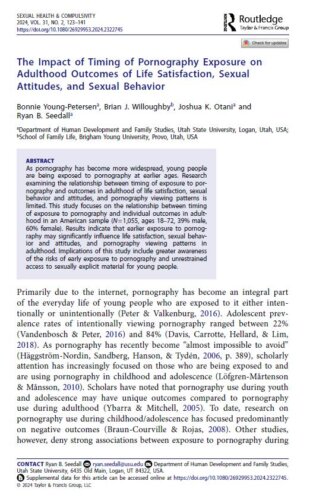Mental Health
The Impact of Timing of Pornography Exposure on Adulthood Outcomes of Life Satisfaction, Sexual Attitudes, and Sexual Behavior.
Open Access: No.
Abstract
As pornography has become more widespread, young people are being exposed to pornography at earlier ages. Research examining the relationship between timing of exposure to pornography and outcomes in adulthood of life satisfaction, sexual behavior and attitudes, and pornography viewing patterns is limited. This study focuses on the relationship between timing of exposure to pornography and individual outcomes in adulthood in an American sample (N = 1,055, ages 18–72, 39% male, 60% female). Results indicate that earlier exposure to pornography may significantly influence life satisfaction, sexual behavior and attitudes, and pornography viewing patterns in adulthood. Implications of this study include greater awareness of the risks of early exposure to pornography and unrestrained access to sexually explicit material for young people.
Relevance
“Our findings suggest that those reporting earlier exposure to pornography are more likely to report less life satisfaction, higher levels of pornography use, more sexual partners, and more acceptance of violent/coercive pornography during adulthood are associated with earlier exposure to pornography.”
“Our analyses consistently revealed that those who were the youngest at exposure (ages 7–11) were more likely to report experiencing less life satisfaction in adulthood than those exposed at later stages or who had never used pornography.”
Citation
Young-Petersen, B., Willoughby, B. J., Otani, J. K., & Seedall, R. B. (2024). The impact of timing of pornography exposure on adulthood outcomes of life satisfaction, sexual attitudes, and sexual behavior. Sexual Health & Compulsivity, 31(2), 123–141. https://doi.org/10.1080/26929953.2024.2322745

